- News
- Reviews
- Bikes
- Accessories
- Accessories - misc
- Computer mounts
- Bags
- Bar ends
- Bike bags & cases
- Bottle cages
- Bottles
- Cameras
- Car racks
- Child seats
- Computers
- Glasses
- GPS units
- Helmets
- Lights - front
- Lights - rear
- Lights - sets
- Locks
- Mirrors
- Mudguards
- Racks
- Pumps & CO2 inflators
- Puncture kits
- Reflectives
- Smart watches
- Stands and racks
- Trailers
- Clothing
- Components
- Bar tape & grips
- Bottom brackets
- Brake & gear cables
- Brake & STI levers
- Brake pads & spares
- Brakes
- Cassettes & freewheels
- Chains
- Chainsets & chainrings
- Derailleurs - front
- Derailleurs - rear
- Forks
- Gear levers & shifters
- Groupsets
- Handlebars & extensions
- Headsets
- Hubs
- Inner tubes
- Pedals
- Quick releases & skewers
- Saddles
- Seatposts
- Stems
- Wheels
- Tyres
- Health, fitness and nutrition
- Tools and workshop
- Miscellaneous
- Cross country mountain bikes
- Tubeless valves
- Buyers Guides
- Features
- Forum
- Recommends
- Podcast
review
£5,800.00
VERDICT:
Super light and lively road bike that flies up the climbs, with many other talents too
Weight:
6,270g
Contact:
At road.cc every product is thoroughly tested for as long as it takes to get a proper insight into how well it works. Our reviewers are experienced cyclists that we trust to be objective. While we strive to ensure that opinions expressed are backed up by facts, reviews are by their nature an informed opinion, not a definitive verdict. We don't intentionally try to break anything (except locks) but we do try to look for weak points in any design. The overall score is not just an average of the other scores: it reflects both a product's function and value – with value determined by how a product compares with items of similar spec, quality, and price.
What the road.cc scores meanGood scores are more common than bad, because fortunately good products are more common than bad.
- Exceptional
- Excellent
- Very Good
- Good
- Quite good
- Average
- Not so good
- Poor
- Bad
- Appalling
Trek's new Émonda range is all about light weight and the Shimano Dura-Ace equipped SLR 8 is an incredibly lively bike that flies up the climbs, but it has many other talents too.

Find the Trek Émonda SLR 8 online
Find a Trek dealer
Weight
Go to the Émonda page on Trek's website and you're greeted with the headline: 'The lightest production road line ever'.
"Every detail of the Émonda line, from frame design to each component choice on every model, serves the same audacious goal: to create the lightest line of production road bikes ever offered," they say.
"Émonda is the ultimate lightweight road racing machine, pushing the boundaries of what's possible for bicycle weight and ride performance."
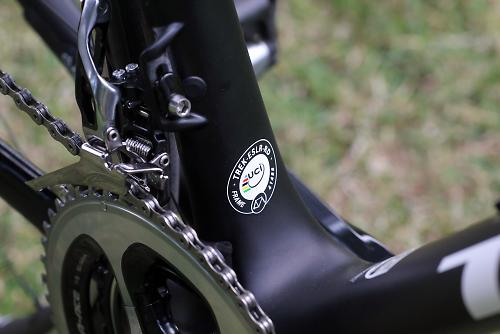
You might be getting the slightest impression that Trek see weight as a key factor here so let's deal with that straight away.
There are three levels of Émonda frame: the S, which is the cheapest version; the SL; and the top-level SLR, which is the one we have here. The SLR is the lightest. Trek claims a frame weight of just 690g for a 56cm. That's as light as production frames come, edging out the Cannondale SuperSix Evo by a fraction to become the current Lightweight Champion of the World.
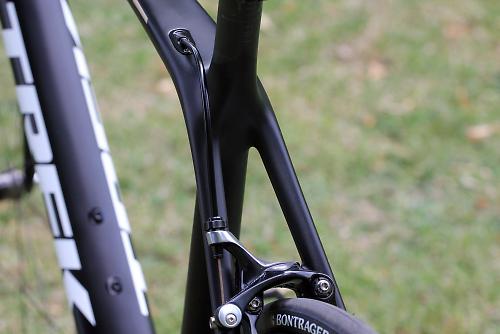
How have Trek made the frame so light? They say that they've given the Émonda the most sophisticated tube optimisation of any bike ever, with both the tube shape and the laminate designed to produce the highest stiffness-to-weight ratio possible.
Trek haven't gone after impressive aerodynamics with the Émonda – they've left that to the Madone – so most of the frame elements are round or, at least, much rounder than you'll find on an aero road bike, with thin walls. Squeeze the central section of the top tube between your finger and thumb and you can actually press the upper wall in very slightly. Don't worry, it returns to normal when you remove the pressure, but that's an illustration of how ruthless Trek have been in pursuit of lightness.
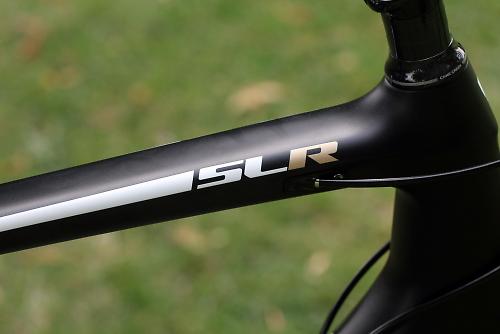
The bottom bracket is BB90 standard (90mm wide) for extra stiffness and Trek use a 1 1/2in lower headset bearing – as many other brands do on their performance bikes – for more rigidity up front. The seatstays are wide-set, attaching to the outside of the seat tube, the idea there being to provide extra stiffness without the need to use more material and increase the weight.
Trek have integrated features into the frame mould to reduce the amount of material they need to use and, therefore, keep the weight down. The carbon front mech mount, for example, is a part of the frame rather than something that has been bolted on afterwards. The same goes for the bottle cage bosses.

Rather than use a standard seatpost, Trek have gone for an extended seat tube topped with a seat mast to cut more grams, and direct mount brakes reduce the overall weight still further. The fork is superlight too: just 280g.
The Émonda SLR is available as a frameset for £3,000, or built up in six different flavours including a women's specific model. Plus, you can customise your own version through Trek's Project One program.
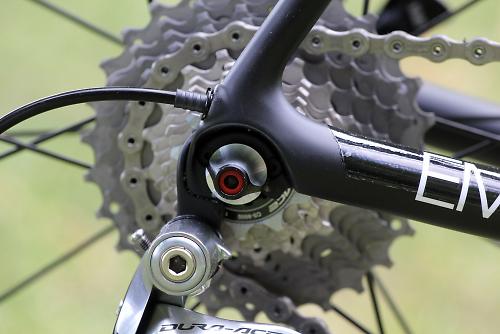
The super-duper top-end build is the Émonda SLR 10 which comes tricked out with a SRAM Red 22 groupset, Tune wheels and saddle, Bontrager's Speed Stop brakes and XXX integrated bar and stem (XXX is the model name, not just a space filler until I get around to looking it up). That complete build weighs in at an astonishing 4.65kg (10.25lb). It'll cost you 11 grand, mind.
Our SLR 8, priced at £5,800, gets a full Shimano Dura-Ace groupset and other components from Trek's in-house Bontrager brand, including RXL Tubeless ready wheels, an XXX OCLV carbon handlebar and Paradigm saddle.
This complete bike (without pedals) hit the road.cc Scales of Truth at 6.27kg (13.79lb) putting it among the very lightest bikes we've ever reviewed around these parts.
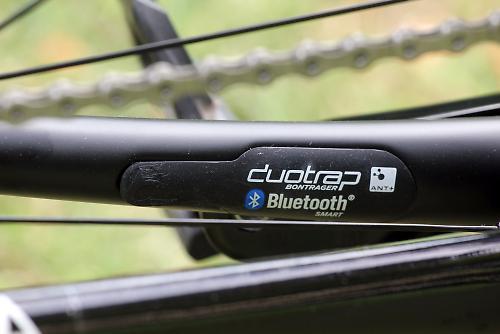
What's the point of such a light bike when the UCI has a 6.8kg minimum weight limit? Well, for a start, most people won't be racing in UCI-sanctioned events. Even if you do, the low weight gives you the option of running deeper section wheels, for example, without being at a weight disadvantage to other riders, or a more cushioned saddle, or some other heavy component that's important to you, like a crank power meter. Oh, and there's always the bragging rights that come with the territory, of course.
If it concerns you that all the gram shaving will result in a lack of durability, Trek offer a lifetime warranty on manufacturing defects, plus a one year warranty on the paint and finish.
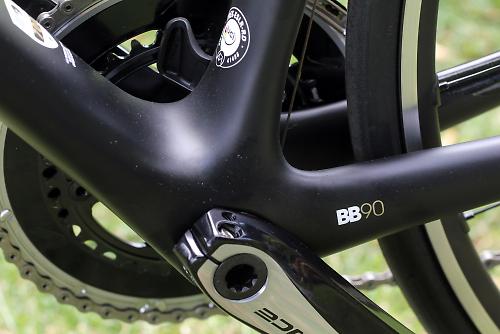
Ride
About once a year a bike comes along for review at road.cc that I really don't want to send back, so I spin the test period out for as long as possible. The Émonda SLR 8 is the one for 2014. This is a bike that's astonishingly quick on the hills, flattering your climbing abilities, and it's easy to live with for long hours in the saddle.
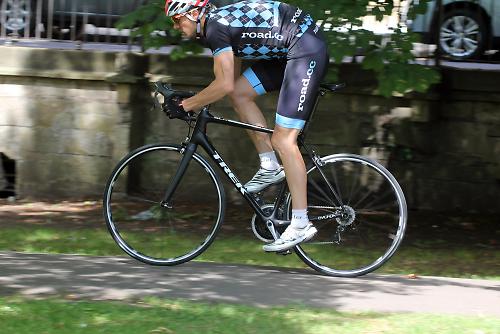
Weighing in at about a pound below the UCI's minimum weight limit for racing, the Émonda SLR 8 takes very little coaxing up to speed. It's one of those bikes that almost makes you feel like you're cheating when accelerating out of a tight corner; I guess you would be cheating if you rode it in a UCI-sanctioned event.
The Émonda is at its best on the hills. The steeper it gets, the better the bike feels. Get out of the saddle for the severe stuff and the frame holds its shape impressively, and the same goes for the fork. When you pick up the Émonda and feel just how feathery it is, you imagine it'll bend about all over the place as soon as it comes within a yard of a flexed quad, but that's far from the case. That front end feels solid and there's barely a hint of sideways movement at the bottom bracket.

Trek say that the Émonda SLR frame is a little stiffer than that of the equivalent Madone. The figures are close but they have to compromise the Madone's stiffness slightly in order to get the extra aerodynamic efficiency. Riding the two of them, you'd be hard pressed to tell the difference, but the bottom line is that the Émonda feels like a strong, firm platform from which to launch your best high-power moves.
Like the frame, Bontrager's Race X Lite tubeless-ready alloy clinchers are lightweight and unexpectedly stiff. The rims are shallow section rather than deep and aero, and it doesn't take a genius to work out why: Trek have one eye on the scales with every component choice here.
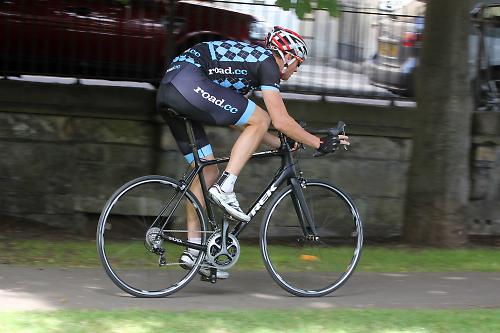
One of the rear straight-pull spokes snapped on me while I was out on one ride, causing the wheel to go so far out of true that it wouldn't even spin between the chainstays, but that was a one off. I put a lot of miles into this bike and this was the only mechanical issue I had, so I'm inclined to put it down as 'just one of those things'. Annoying, but forgivable.
As if you needed any help getting up the climbs on a bike this light, our Émonda SLR 8 was fitted with a compact chainset with 50- and 34-tooth chainrings. It's only the H2 version (see below) that gets this, the H1 model comes with a grown-up 53/39 chainset.
I'm definitely more of a spinner than a stomper when it comes to pedalling technique, but I found this bike undergeared. The lowest combination is a 34-28. Maybe you'll like that setup but, personally, I'd have preferred a standard chainset or a 52/36 semi compact. One of those would suit the character of the bike far better, in my opinion, but you'll know what works for you.
The brakes deserve a special mention. As I said, Trek use direct mount brakes on the Émonda SLR bikes, as they do on the high-end Madones. The Shimano Dura-Ace direct mount brakes used here are fantastic. Granted, braking on an alloy rather than carbon brake track helps, but there's no doubt that these are a bit special, giving you a feeling of control even when you're slinging the bike into fast, mysterious bends. You know that there's enough power at your fingertips to save you if things get hairy. I've got nothing but good things to say about these brakes. Approved!

In terms of ride feel, I found the Émonda pretty comfortable. I had a high saddle (I always do) and that meant I got quite a bit of movement from the extended seat tube and seat mast to provide a degree of damping over the rough stuff. As ever, the saddle is going to be a matter of personal taste, but I got on well with the shape of the Bontrager Paradigm and there's a significant amount of flex in the shell.
Things are more direct at the front end with bumps, holes and gravel making their presence felt through Bontrager's XXX VR-C handlebar, but even the worst road surfaces feel relatively smooth and don't threaten to knock you off your line. I actually really like that carbon fibre bar, although some people might want a drop of more than the 124mm you get here.
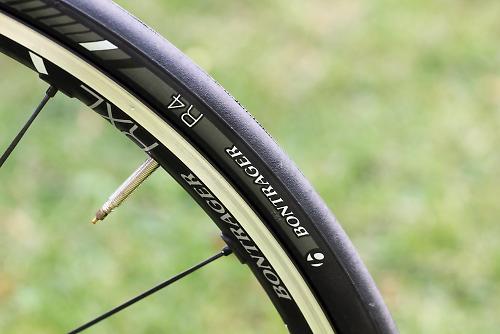
If you do find yourself lacking comfort and/or not sticking to the ground over the rough stuff, wider tyres would certainly help. The Émonda SLR 8's Bontrager R4 tyres are very lightweight (I wore through the rear one quite quickly) and sticky but they're only 23mm wide. Going for 25s or even larger would considerably alter the feel of the ride – as they would on any other bike, of course.
Trek reckon that the Émonda has a 'size-specific ride-tuned performance'. In other words, they've engineered things so that each size feels and performs exactly the same. I couldn't very well jump off a 58cm model and on to a 50cm one to verify this so we'll have to take their word for it.
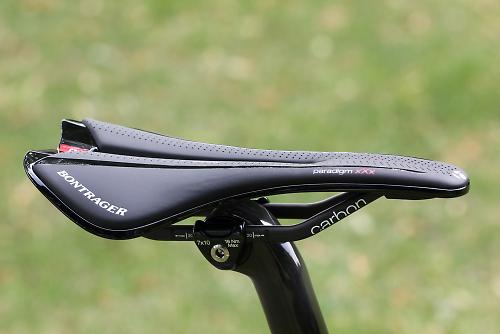
Weaknesses? Well, in these times when everything in the performance section of the bike world is aero-this, aero-that, Trek have produced a bike that's not designed with aerodynamics in mind at all. The Émonda is lightweight all the way.
Trek's solution is simple: if you want aerodynamics, go for the Madone. If you want comfort, go for the Domane. If you want lightweight, go for the Émonda. Okay, that's nice and simple, buuuuuut, what if you want all of that and don't have enough cash to shell out for one of each? I guess you just have to decide which aspect of the performance you value most and make your purchase accordingly.
Geometry
Our SLR 6.8 is built to Trek's H2 geometry because that's what Trek had available when we asked to borrow one, but it's also available in H1. If that makes no sense to you, H2 is a race fit, but it's not as aggressive as Trek's low and aero H1 fit.
Our 58cm model comes with a 59.6cm stack height (the vertical distance between the centre of the bottom bracket and the top of the head tube) and a 39.1cm reach (the horizontal distance between those points). The head tube is 19cm tall.
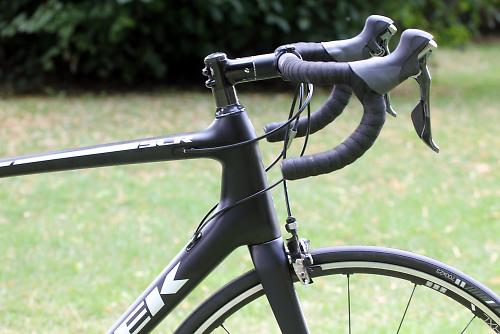
Those measurements are all very similar to – or in some cases exactly the same as – those of an equivalent Madone, although the Émonda's chainstays and wheelbase are slightly longer, the idea being to add a touch more stability.
Go for an H1 fit and you're talking about a 56.7cm stack (2.9cm lower than that of the H2 fit), a 40cm reach (0.9cm longer), and a 16cm head tube (3cm shorter). In other words, you'll be bent over and stretched further with the H1 geometry.

Geometry comes down to the individual, of course; what suits one rider won't necessarily suit another. When I first jumped on our review bike, the front end did feel too tall for me but I managed to get into a position that felt low and efficient by removing all the spacers from underneath the stem. On the whole, I'd rather have had the H1 fit but, like I say, each to his or her own. Speaking of 'her' (seamless, huh?), the Émonda SLR 9 WSD has exactly the same frame dimensions as a standard H2 Émonda.
Don't be tempted to go for the H1 geometry if you don't need it just because you think it's the more pro option. You're better off with an H2 with no headset spacers than with an H1 and a whole stack because of they extra front end stiffness you'll get as a result.
Verdict
Super light and lively road bike that flies up the climbs, with many other talents too
road.cc test report
Make and model: Trek Emonda SLR 8
Size tested: 58, Black
About the bike
State the frame and fork material and method of construction. List the components used to build up the bike.
Frame Ultralight 700 Series OCLV Carbon, ride-tuned performance tube optimisation, E2, BB90, internal cable routing, DuoTrap S compatible, Ride Tuned seatmas, 3S chain keepert, 690g (56cm, weight varies by frame size)
Fork Émonda full carbon, E2 asymmetric steerer, carbon dropouts
Wheels Bontrager Race X Lite Tubeless Ready
Tyres Bontrager R4 Hard-Case Lite, 700x23c
Shifters Shimano Dura-Ace, 11 speed
Front derailleur Shimano Dura-Ace, braze-on
Rear derailleur Shimano Dura-Ace
Crank Shimano Dura-Ace, 50/34 (double)
Cassette Shimano Dura-Ace, 11-28, 11 speed
Chain Shimano Dura-Ace
Saddle Bontrager Paradigm RXL, carbon rails
Seatpost Bontrager Ride Tuned Carbon seatmast cap, 20mm offset
Handlebar Bontrager XXX, OCLV carbon, VR-C, 31.8mm
Stem Bontrager Race X Lite, 31.8mm, 7 degree
Headset Cane Creek IS-8, integrated, cartridge bearings, sealed, carbon, 1-1/8 top, 1.5" bottom
Brakeset Shimano Dura-Ace direct mount
Tape Bontrager gel cork tape
Tell us what the bike is for, and who it's aimed at. What do the manufacturers say about it? How does that compare to your own feelings about the bike?
Trek allow their pro riders to choose between the Madone, the Émonda and the Domane, according to preference and conditions.
The Émonda is the lightweight one.
Trek say, " Every detail of the Émonda line, from frame design to each component choice on every model, serves the same audacious goal: to create the lightest line of production road bikes ever offered.
"The entire Émonda line is unbelievably light, with sensational ride-tuned balance and handling that elevate Trek ride performance to a whole new level."
Frame and fork
Overall rating for frame and fork
9/10
Tell us about the geometry of the frame and fork?
See the Geometry section of the write up.
Riding the bike
Was there any toe-clip overlap with the front wheel? If so, was it a problem?
A little but not a problem.
How would you describe the steering? Was it lively, neutral or unresponsive? Neutral.
Rate the bike for efficiency of power transfer:
9/10
Rate the bike for acceleration:
10/10
Rate the bike for sprinting:
9/10
Rate the bike for high speed stability:
9/10
Rate the bike for cruising speed stability:
9/10
Rate the bike for low speed stability:
9/10
Rate the bike for flat cornering:
9/10
Rate the bike for cornering on descents:
9/10
Rate the bike for climbing:
10/10
The drivetrain
Rate the drivetrain for performance:
9/10
Rate the drivetrain for durability:
7/10
Rate the drivetrain for weight:
8/10
Rate the drivetrain for value:
6/10
As we often point out, you pay much more for Dura-Ace than you do for, say, 105, with a comparatively small step up in performance – but that's how these things work!
Wheels and tyres
Rate the wheels and tyres for performance:
8/10
Rate the wheels and tyres for durability:
7/10
I did break a spoke and went through the lightweight rear tyre pretty fast.
Rate the wheels and tyres for weight:
8/10
Rate the wheels and tyres for comfort:
7/10
Rate the wheels and tyres for value:
7/10
Controls
Rate the controls for performance:
9/10
Rate the controls for durability:
7/10
Rate the controls for weight:
9/10
Rate the controls for comfort:
9/10
Rate the controls for value:
6/10
Your summary
Did you enjoy riding the bike? Very much.
Would you consider buying the bike? If only I had that kind of money!
Would you recommend the bike to a friend? Yes.
Rate the bike overall for performance:
9/10
Rate the bike overall for value:
7/10
Anything further to say about the bike in conclusion?
This is a top-performing bike that boasts a lot of excellent technology. For a bike of this kind, we reckon the performance mark outweighs the value mark, so the overall score of 9 isn't an average of the two. If you're after a superlight bike that doesn't sacrifice stiffness, the Émonda SLR lineup is shouting for your attention.
About the tester
Age: 43 Height: 190cm Weight: 75kg
I usually ride: My best bike is:
I've been riding for: Over 20 years I ride: Most days I would class myself as: Expert
I regularly do the following types of riding: commuting, club rides, sportives, general fitness riding,
Mat has been in cycling media since 1996, on titles including BikeRadar, Total Bike, Total Mountain Bike, What Mountain Bike and Mountain Biking UK, and he has been editor of 220 Triathlon and Cycling Plus. Mat has been road.cc technical editor for over a decade, testing bikes, fettling the latest kit, and trying out the most up-to-the-minute clothing. He has won his category in Ironman UK 70.3 and finished on the podium in both marathons he has run. Mat is a Cambridge graduate who did a post-grad in magazine journalism, and he is a winner of the Cycling Media Award for Specialist Online Writer. Now over 50, he's riding road and gravel bikes most days for fun and fitness rather than training for competitions.
Latest Comments
- Robert Hardy 2 sec ago
The road network is not a sports venue or play park. If people want to race on it, whether on a car motorbike, bicycle or soapbox, then they need...
- Muddy Ford 41 min 27 sec ago
Disgraceful sentence that reinforces the contempt towards cycling. I hope both the driver and judge suffer a serious illness.
- slc 1 hour 48 min ago
I think it has got better in some locations. For example, Baldwin Street and Victoria Street. Bus gates there have improved conditions greatly for...
- lawrence18uk 9 hours 10 min ago
" in what appears to be two random, completely unprovoked attacks."...
- hawkinspeter 10 hours 2 min ago
You could get away with much less turning area required if you go for a Kakeya set...
- Gbjbanjs 10 hours 21 min ago
Any chance we could have bike reviews for people with normal disposable incomes? My ti bike cost £2k, brilliant, versatile.....
- matthewn5 11 hours 20 min ago
I built a gravel bike last summer - a Ridley Kanzo Fast with Campag Ekar - and have used it through the winter with mudguards for club runs and the...
- David9694 14 hours 54 min ago
Another Conservative bemused at how but a Conservative policy is turning out
- Global Nomad 20 hours 24 min ago
would be good to see you test the Newmen wheels the weight/price ratio is extremely good and suggests that europeans can match the chinese in this...















































Add new comment
18 comments
Plenty of fat people will buy this.
The cost-value ratio isn't that great is it?
At retail pricing a £1000 DA group, £1000 wheels (similar to Hed Ardennes, which I'd rather have BTW), £350 bar/stem combo (similar to Canyon or Cinelli Ram) and a £200 saddle makes for one EXPENSIVE mass produced frameset!
This is up into the Parlee, Storck, Cervelo or AX Lightness range which we know is high quality.
I'd say it's a tough sell given the brand name.
Only the most expensive model is under 5kg, every other model is above 6kg. While that is very light u can get a Bike from Rose for half of the price of the second most expensive model Emonda. The ROSE X-LITE TEAM-8800 is €4270 and only 5.8kg and absoluut top components while the Émonda SLR 9 WSD is €9299 and 6.09kg.
I'd rather put 2kg of water on a 6.5kg bike than on a 8.5kg bike.
No doubt it may stand up well in pro circles, but to me this bike appears to be another vastly expensive 'marginal gains' machine. Don't forget the 2kg of water, that likely goes on straight away for any ride of a decent length, not to mention one's own possibly not so 'finely tuned' body weight.
That's because that is precisely what it is.
Yeah, Cannondale claim the same thing about the supersix evo... 'it's the lightest production frame in the world'.
I don't know why manufacturers even attempt to play that game - it's the old 7 minute abs problem, someone will come along next week with the 6 minute abs workout and they'll lose credibility.
Why can't they just say 'its a f***ing light bike that'll go like the wind etc etc'? Its a shame because the Emonda does look like a lovely, understated, quality bike, but their childish marketing claims really put me off.
dont forget trek also claim the Madone is is the most succesful tour du france winning bike in history as well.
they do make up some wonderful tripe.
Not sure why you are focussing on a price versus weight comparison, Koen. We don't. We are focusing on frame weight, and how light a bike it's possible for someone to get from any Trek retailer in the world.
We also aren't misleading anyone with our weight claims. The SLR frame is 690g. How a person chooses to spec that will determine the overall weight of the frame, so of course it's possible that even with an SLR frame, there will be lighter options if someone chooses to spec with say, 105 instead of something lighter. They're still starting with the lightest production road frame, however.
The SL and S frames are heavier in relation to the SLR, and we don't hide that. It's also still possible to make a very light bike starting with those frames.
same weight as the supersix evo
To clarify some of the issues raised about the weight of the bike:
The SLR 10 is the lightest production road bike on the market as of now. It is not the lightest bike ever made, nor are we claiming as much. Clearly, it's possible to make bikes that weigh less in both frame and complete setup as the SLR frame/SLR 10. But to do so on a large scale, with consistency in the manufacturing process, is much more difficult. This is why we specifically use the term 'lightest production line', rather than simply saying it's the lightest bike ever. It's not even the lightest bike we've ever made as a one-off.
When we quote frame weight, it's also important to remember that our frames include the seat mast, which adds more overall material to the frame than a traditional seatpost set up.
Also, we don't actually make any claims about price versus weight in our literature. We are rarely the least expensive model available in a given category, largely because we offer a higher quality frame, which adds cost to the overall package. If there have been reviews suggesting that for the weight, the Émonda is the cheapest option out there, then that has been the observation of the reviewer, rather than a representation of our own claims.
Well the bikes i summed up are all lighter than the same priced (or higher) from Trek, and those are all production bikes (Rose and Canyon don't do custom bikes).
But now that you're saying only the SLR 10 is the lightest, it's different matter and not really clear on your site.
Note that i don't hate Trek (or any bike brand for that matter), but i don't like it when customers don't get the right information. And yeah the frame probably is worth the price so it should be more clear on your website that u guys are talking about that.
We see you, Mr. Brett. We haven't forgotten that you have this bike.
They're talking about the bike, not just the frame.
I'm not talking about this review in general, but most of them do it about this bike. And they aren't talking about the frames alone as they have alot of different bikes with each it's own configuration. And as they use their own branded material (wheels, bars,...) i do think they meant the whole bike. And this quote from Trek (on their website) " to create the lightest line of production road bikes ever offered." doesn't say frame but bike.
http://www.trekbikes.com/us/en/bikes/road/performance_race/emonda/
They probably have the lightest frame of those bikes yes, but they do mean bikes not the frame alone.
It's probably a very good bike and very light bike but it isn't the lightest bike in it's price range.
To be fair the review doesn't say it's the lightest bike they've ever had, just that it's among the lightest.
As for the weights, the claims Trek are making seem to be for the frame only . I'm not going to look at the frame weights for the bikes you've listed but if they're higher, then they're not lying, are they?
You might argue that it doesn't matter but that's a different argument!
"...flies up the climbs". mmm. On last week's clubride only one rider could be said to have "flown up" one particular climb and he was riding some monstrous chopper of a winter bike with a chunky frame, sit up and beg bars and heavy industrial wheels. Not sure the marketing men would be happy about that and the rest of us trailing in his wake weren't that happy either
Good review but everything i read about the Trek Emonda says it's the lightest bike in their price range. But that's so not true, Canyon, Rose and many other brands have much better weight for the price. For example:
-Emonda S6 is about €2200, size 56 cm: 8,83kg.
-Canyon Ultimate AL SLX 9.0 SL, €1999 size 56cm: 6.95kg.
-ROSE XEON CRS-3000, €1981 size 57cm: 6.85kg.
-ROSE X-LITE CRS-4400, €2.185 size 57cm: 6.55kg.
So in NO WAY is Trek the lightest, so why are they saying it so much? And why doesn't anyone point that out in reviews.
BTW, i'm not a weight weenie in anyway (my Specialized Allez is about 10kg), but i don't like it that brands come away with lies and that even reviewers don't ask those questions.
Edit: I also compared this reviewed bike to other bikes:
-Trek Emonda SLR 8, €6799 size 56cm: 6.15kg
-ROSE X-LITE TEAM-7000, € 4828 size 57cm: 5.95 kg
-Canyon ULTIMATE CF SLX 9.0 LTD, €4499 56cm: 6.20kg (ok it's 0.05kg heavier but it's €2300 less).